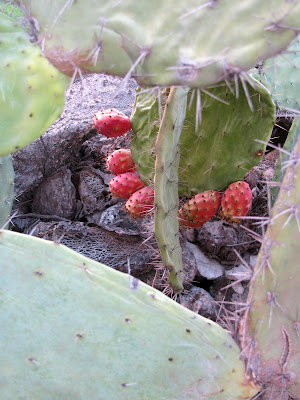Sitvanit's common name is Steven’s Meadow saffron, while its scientific name is Colchicum stevenii Kunth. The flower is dedicated to Christian von Steven, author of various transactions of the Imperial Society of Naturalists of Moscow published since 1838. In Hebrew it is known as Sitvanit HaYoreh (סתוונית היורה): Sitvanit from Stav meaning autumn and HaYoreh, the name of the first rain of the season. The Sitvanit is a perennial plant that belongs to the Lily family, along with the Lilies, Tulips, and Hyacinths. It is referred to in the Mishnah (the oldest authoritative postbiblical collection and codification of Jewish oral laws) where it is said to be used to produce vinegar. In addition, the Colchicum species contain Colchicine, originally used to treat rheumatic complaints and especially gout. Its present medicinal use is mainly in the treatment of gout; as well, it is being investigated for its potential use as an anti-cancer drug.
There were also a few remaining red sabra (prickly pear) fruit left on the Opuntia cactus. This cactus has large flat pads (which, incidentally, are also edible), thorny fruits, and flowers that blossom annually. Sabra cacti can be seen scattered throughout the Israeli hills, where they were often planted to serve as natural dividers and barriers.
* This post has been shared on Our World Tuesday, Outdoor Wednesday, Wednesday around the World, Wow Us Wednesdays, {wow me} wednesday, Little Things Thursday, Encouraging Hearts & Home Blog Hop and Wordless Wednesday (on Tuesday).





































11 comments:
So pretty!
Lovely little flower
There are so few treasures to be found in nature this year. I do hope for some proper rain and soon. I haven't seen a Sitvanit in ages.
Amalia
xo
You live in a land of wonder. Those delicate purple flowers rising out from among the dry foliage touch my heart. :-)
Thank you for showing us this lovely little flower. Enjoy the winter rains. I'm joining you this week from Wednesday around the world.
So very beautiful! Happy weekend!
It is amazing what lurks beneath the soil, just waiting for some rain to wake it up! Thanks for the detail in your post - very interesting! I love cactus of all kinds!
Those pale lilac flowers are so adorable!
I don't really know what your weather is like this time of year, but I'd be delighted to see something blooming just now!
Hope you had a wonderful Hannukkah.
Thanks for joining us at https://image-in-ing.blogspot.com/2017/12/wishing-you-merry-christmas.html
I find it comforting to have places closeby that usually have some surprises at each visit. Thanks for the information about all of your finds!
The rain flowers are so pretty and delicate. Thank you for giving their history too. Have a happy new year too!
Post a Comment